Are you stuck in a schedule that’s less than optimal? Check out this short presentation by Craig Ballantyne, the man that took over Early to Rise after I retired from it.
Iran? Iraq?
Something I try to do every day: learn something interesting, useful, or in some other way worth remembering. This morning, during a conversation about I don’t know what, someone said, “Iran. Iraq. What’s the difference?”

The only difference I knew was that in 2003 we (the US) invaded Iraq. Not Iran. What else did I know? That was it!
So I spent a half-hour reading and took these notes:
* Iran and Iraq share a 900-mile border and three-quarters of their names. However, the two countries have different histories and cultures, influenced by shared and unique invaders, emperors, and foreign rulers.
* Iran (pronounced ee-RON) was formerly Persia. Iraq (pronounced ee-ROCK) was formerly Mesopotamia.
* Iran means “land of the Arians.” Iraq means “city.
* Tehran is the capital city of Iran. Baghdad is the capital city of Iraq.
* Iran is 3 times larger than Iraq.
* Iran is a religious state (The Islamic Republic of Iran). Iraq is a constitutional democracy.
* The US invaded Iraq in 2003, and reformed its government. But not Iran.
* Iran is 90% Shia and less than 10% Sunni. Iraq is 60% Shia and almost 40% Sunni. These two Islamic sects have been fighting since the 600s.
* Both countries are major suppliers of crude oil, producing more than 4 billion barrels per day.
So How’s Biden Doing on His Big Immigration Promises?
“It ain’t what you don’t know that gets you into trouble. It’s what you know for sure that just ain’t so.” – Mark Twain
When they took over, the Biden administration was confident that it could quickly repair the trouble on the southern border. People would no longer be held in cages. Children would no longer be separated from their parents. Migrants seeking asylum would be processed in a humane and orderly way.
On March 23, Biden signed a series of executive orders meant to reverse some policies created in the past 4 years. “We’re going to work to undo the moral and national shame of the previous administration that literally, not figuratively, ripped children from the arms of their families… and with no plan – none whatsoever – to reunify the children,” he said at the signing ceremony.
So how is all that working out?
It’s not easy to say with any certainty. That’s because the Biden administration isn’t allowing the media into the processing centers. Asked to explain this (which did not happen under Trump), Biden said that he “fully intends to be fully transparent” about the situation. Just not right now.
Many of the media are apparently okay with that. I suppose they feel certain that, whatever the conditions, they must be better than they were last year. And so there has been virtually no reporting on it from the NYT, CNN, etc. since Biden took office.
But what if it just ain’t so?
It turns out that some of the Customs officers are talking. One of them, who was willing to give only his first name, Carlos, reported the following conditions at the South Texas facility:
* Up to 80 individuals are living in 24- by 30-foot cells.
* Sheets of plastic divide the cells.
* As of 3/25, there were not enough mattresses for everyone.
* One or two agents are left to control 300 to 500 people per shift.
* Agents are leery of reporting physical or sexual assaults between the migrants because they’ll get blamed for “letting it happen.”
* Children with biological parents are being kept together.
* Children accompanied by extended family members are being separated from them.
* The number of unaccompanied minors – children under 18 who arrive without a parent – is growing daily. The law requires Border Patrol to prioritize unaccompanied minors and transfer them to the Department of Health and Human Services within 72 hours. But many are staying for 10 to 12 days.
* The majority of unaccompanied minors coming across the border already have parents or family members in the United States.
* Two-thirds of migrants traveling through Mexico report experiencing violence during the journey, including abduction, theft, extortion, torture, and rape, according to Doctors Without Borders (MSF). (MSF has been providing medical and mental health care for migrants and refugees in Mexico since 2012.)
* Almost 1 in 3 women surveyed by MSF said they had been sexually abused during their journey. 60% through rape.
Biden doesn’t like any of this. In fact, he doesn’t like it so much that he asked Kamala Harris to be in charge of this messy job.
I’m sure he and Kamala would like nothing better than for things to turn out exactly as they promised they would, once they took charge and rescinded Trump’s executive orders.
And so now, we have this surge of migrants at the border seeking asylum, and a larger surge of migrants crossing the border illegally. And because it’s well known, south of the border, that after processing, most asylum seekers and illegal entrants are allowed to enter the US so long as they promise to come back for a hearing, the Mexican cartels that are transporting many of them are actually throwing children over the walls!
Here’s what I’m wondering: How could anyone actually believe that loosening restrictions would not cause an unmanageable surge?
There are more than 300 million poor people below living below the border. And virtually all of them know that being poor in the US is much, much better than being poor where they are. They have friends and relatives that have made it to the US and are working as gardeners and housekeepers and making more than doctors do in their own countries. Why wouldn’t many of them want to do the same?
By the way, I’m all in favor of not just allowing immigration, but promoting it. But the idea that it’s somehow immoral to rationalize the process by controlling and vetting immigration is just plain stupid. Every other developed country in the world does it. Heck, just about every developing country does it too.
There are solutions to this. Solutions that sensible people from both sides of the political divide should be able to agree to. For one thing, we could do what the Canadians do: Make illegal immigration absolutely illegal. And, at the same time, introduce a large-scale temporary worker program that would permit hundreds of thousands of vetted and qualified foreigners to work in the US on permits for designated periods of times. In some cases, it could be months; in most cases, years, with the ability to return home to visit their families.
Unfortunately, that’s not going to happen because the political argument is based on lies. Open border advocates want to add millions of low-paid or no-paid immigrants to the population because they believe it will increase their voter base. And anti-immigration advocates want to severely limit immigration from Mexico and Central America because they fear the same thing.
Poverty in Mexico and Central America is a big problem. A big, humanitarian problem. But once a humanitarian problem becomes a political issue, the human factor disappears, and things usually go from bad to worse. That is what’s happening now at the border.
I do not think AOC is as vacant-headed as she sometimes appears to be. I see her as an intelligent, badly educated person with immense charisma in a millennial sort of way. She made headlines last year when she visited the border and railed against the inhumanity of what she believed were Trump’s policies there. (They were largely the same policies that existed during the Obama administration.) She has not been down there since the surge began, but she did defend that decision in a blog she posted last week.
In the video below, Ben Shapiro, who IMHO is the brightest political podcaster on the internet, is trying to figure out what, exactly, she is saying. It’s a good bit of fun. See what you think.
“Inside of every problem lies an opportunity.” – Robert Kiyosaki
Where to Invest in Real Estate in 2021 and 2022?
Back in June, I said that my partners and I had put a hold on plans for a $14 million company-occupied office building. Though I wasn’t concerned about the future of that kind of real estate, we wanted to see what would happen with the economy before committing to construction.
That was then. Here’s what I’m thinking now…
Office space will never recover fully. Those of us that own commercial office properties will be lucky if rental income climbs back up to 70% of where it was.
So where is the opportunity in real estate going to be in 2021 and 2022?
And what should my partners and I do with all these damn office buildings we own that will now be less than fully occupied?
In a recent issue of Empire Financial Daily, Whitney Tilson had this to say…
[In June] people were fleeing urban apartments and seeking more room for home offices along with private outdoor space.
Even that early in the pandemic, it was clear that the nature of work could be permanently altered – with less time in the office likely an enduring reality for many folks – supporting the possibility that temporary relocations could become permanent.
In October, I said pretty much the same thing, and noted an email I had received from a tenant in one of our buildings. They were not renewing their lease because “Our employees have told us that they like working at home and, as you’ve noticed from the monthly reports, the business hasn’t suffered in terms of revenues or profits. This will save us more than $100,000 next year.”
Whitney again:
What I didn’t appreciate at the time – and what has become a key tailwind for strength in housing prices – is how constructive the supply side of the equation has proven to be…. [T]ight supply is proving far more persistent than what a few weeks of building shutdowns would create.
Put into hard numbers, there were nearly 500,000 fewer homes available for sale in February 2021 versus February 2020. You can see the dramatic decline in inventory in this chart from The New York Times…
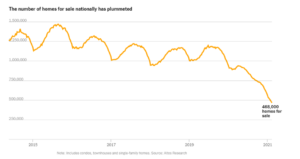
What’s driving the supply shortages?
Whitney has several theories:
* Some retirement-age people are putting off selling their homes until the COVID scare is over. “The idea of having a bunch of strangers traipse through the house you live in is off-putting in the best of times, and the past year held risks that went beyond mere inconvenience.”
* The supply of new housing builds “never recovered to the levels seen before the industry crash of 2008 and 2009. In classic feast-to-famine mode, the homebuilding industry may have overcorrected.”
* Low interest rates (which have been in place for nearly 13 years now) “have incentivized people to get into the landlord business.” (In fact, the number of homes for rent – not sale – has surged while the supply of new houses has dipped.)
All of this suggests that the smart money should be directed into the residential housing market. But there is one caveat, which Whitney notes. For the last 8 years or so, the cost of new housing and new construction has been going up, but average rental income is falling.
From Whitney:
As this chart from the [NYT] article shows, it’s happening in nearly every major metro area…
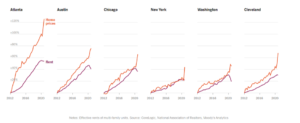
That is, of course, the opposite of what you’d want if you were going to invest your money into building rental housing.
But Whitney is not deterred by this. He says:
At the risk of uttering the most dangerous words in finance, I would suggest that this time may in fact be different.
Rents are falling because renters still overwhelmingly live in apartments. According to a 2016 Harvard study, 61% of the US rental stock is multifamily (apartments), and only about 28% of rental properties are detached homes. (The remainder consists of attached homes, mobile homes, and RVs.)
Additionally, 46% of rental units are in cities, with 42% in suburbs and 12% in rural areas.
Moreover, notwithstanding the 30-year mortgage rate recently hitting 3% for the first time since July, rates still remain quite low on an absolute basis. Prior to July 2020, rates hadn’t been below 3% at any point in the 50 years people had been keeping track. Three percent is still a fantastic mortgage rate.
Whitney again:
I think this housing boom has legs and should be supportive of the homebuilders and building-products suppliers for several quarters to come. Many of the factors for a strong housing market – such as low interest rates, improving employment, and stable to improving consumer confidence – are firmly in place, and now a supply shortage has been layered on top of these macro factors.
So, what about all those buildings we have – that are now 90% vacant? What are we going to do with them?
I don’t know. My partners and I are having discussions about whether we should demand that all our employees return to their desks once the fear of the pandemic has abated. Some argue that we must, that physical proximity is the only way to optimize communication and to initiate new employees into the existing corporate culture. I don’t agree. I believe that many, if not most, of our employees have realized that there is no reason for them to commute to their jobs, and spend 8 or more hours inside a box inside a bigger box. They will want to continue to work as they have been working, from home or from a coffee shop or from a park. And I believe we will all work more efficiently with less physical contact.
What we do agree on is that we should let the CEOs that have been running these businesses successfully these past 12 months make their own decisions. And my guess is that will result in a decreased need for office space by at least 30%.
We are going to have to sit and see what happens for the rest of this year. In the meantime, I’m going to be thinking about converting some of that space into residential apartments!
Feeling stressed? There’s nothing like juvenile humor to correct that…
A Surprising Benefit of the Lockdowns
I came down here at the end of March to check on some improvements we’ve been making at FunLimon. (FunLimon is the community development center my family and I have been developing across the street from Rancho Santana.) K joined me a week later. For 20 years, my/our sojourns in Nicaragua lasted a week to 10 days. There were always reasons to be back in the States or at some office in Europe or Asia or elsewhere.
But that all, suddenly and amazingly, changed in 2020. The lockdowns forced us to have our business meetings digitally and, notwithstanding predictions to the contrary, it worked out surprisingly well. We meet more often, spend less time in redundant conversations, arrive at decisions faster, and – speaking for myself at least – feel much more connected than before, when I was spending, on average, two months a year on planes and in hotel rooms.
And that is why we were able to spend so much time here this time. There was no reason not to stay longer.
I am grateful for that, and optimistic about how the Zoom environment is changing business. That’s a subject I’ll be talking about in a future posting. Today, as K and I are preparing to fly home, I wanted to share some photos and thoughts with you about why we are always happy to spend extra time in Nicaragua.
Progress at FunLimon!
Last week we inaugurated FunLimon’s new and improved facilities.
Among the improvements was a renovated gymnasium.

The gym now has new equipment, a room for group classes, a remodeled martial arts center, and AC for all. (But only when it’s above 80 degrees!)
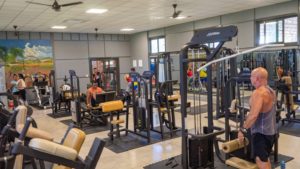

We rebuilt the building in which we host English language, Spanish literacy, and computer classes.

We modernized the trade school building to allow for more students and more trades.
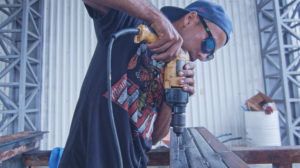
We built a brand-new building to accommodate the expanding personnel that work in management, and attached to that a suite of dorm rooms for visiting teachers’ volunteers.

We created a new service entrance and parking lot for our employees, and created a “quad” for students and visitors to rest in between classes.
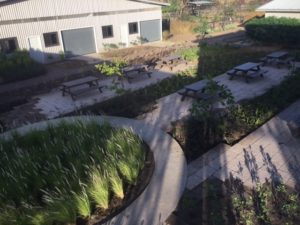
Next on the agenda: expanding and improving the kids’ playground, and enlarging the soccer/rugby field to meet international standards. (One of Rancho Santana’s sponsored soccer teams has made its way up to Division B status.)
This next photo was taken at the Major League Players Association Clinic that is held at FunLimon every November. It is attended by 200 to 300 young adults and children.

And this one is from a baseball game with the local men’s league…

Finally, here’s a photo of something we’re especially proud of – a recent graduation ceremony for people who have completed our various educational programs…

Things You Can Do (or Could Have Done) in Nicaragua That You Couldn’t Do in the USA
* Nearly die climbing a cliff you shouldn’t have climbed (because you are too stubborn to believe advice about how dangerous it is).
* Get a haircut for $3.
* Surf all year round in one of the best surfing destinations on the Pacific Ocean.
* Make a comfortable Nica-style living working as a part-time English teacher, yoga instructor, fitness trainer, or IT technician.
* Get your car stuck in the mud and have a local farmer haul it out with a team of oxen.
* Buy a small beachfront lot, in walking distance of a five-star resort, for $80,000.
* Have a four-course steak dinner at one of the best restaurants in one of the world’s “best preserved Spanish Colonial cities” for less than $10 per person, including wine.
* Hire a Spanish tutor for $5 an hour.
* Engage in small talk at a cocktail party in 3 or 4 different languages simultaneously.
* Buy a six-year-old an elementary school start-up kit, including a backpack, notebooks, pencils, pens, and a ruler for less than $20. Add a bespoke school uniform, new shoes, and a calculator for another $25.
* Encounter wild monkeys, rare birds, a boa constrictor, and even a puma on a nature walk within Rancho Santana’s 1,700+ acres of forested preserves.
* Travel (first on horseback and then by foot) through nearly 1,000 acres of dense forest to find the source of a river.
* Start your own craft brewery for less than $10,000.
* Get a massage for $15.
* Sponsor a kid’s college education, including tuition, transportation, and food, for $80 a month.
* Buy and build your very own cigar bar, on the beach, for less than $150,000.
* Be asked to judge the swimsuit competition of the Miss Nicaragua contest.
* Hire two full-time caretakers for your aging parent for less than $500 a month.
* Buy and build a quaint, four-cabin, bed-and-breakfast for $150,000.
* Meet personally with two of the country’s last three presidents.
* Hire a full-time housekeeper for $250 a month.
* Buy 1,700 acres of prime beachfront property for $400,000, divide it into several hundred lots, and sell just one of those lots, 20 years later, for $600,000.
* Watch an amazing sunset almost every single evening. (See below.)
A few weeks ago, I mentioned that I was putting together a photo-journal of the sunsets we’ve been enjoying at Rancho Santana. Here are some of my favorites…







